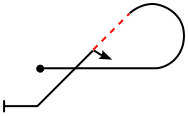Looping night
The Loopingacht is a figure in aerobatics . It was shown for the first time involuntarily by pilot Leonard James Povey in 1936 when he failed an avalanche. When asked by the judges, he spontaneously called the figure a Cuban eight . (Povey was an American, but from 1934–1938 he lived in Cuba and built the air force there on Batista's order.).
The figure consists of two partial loops and two half rolls . The aircraft goes from level flight into a 5/8 loop upwards until it flies 45 degrees downwards on its back against the original flight direction. Now half a roll follows, followed by another partial loop at the height of the first one, until the aircraft flies 45 degrees downwards in the original flight direction. Now another half roll follows.

| figure | description | Aresti symbol |
|---|---|---|
| Cuban eight |
|
|
| half cuban eight |
|
|
|
raised roller turn (English reverse half cuban) |
|
See also
Individual evidence
- ↑ Guide to the Leonard J. Povey Papers 1904-1984 ( Memento June 7, 2010 in the Internet Archive )



